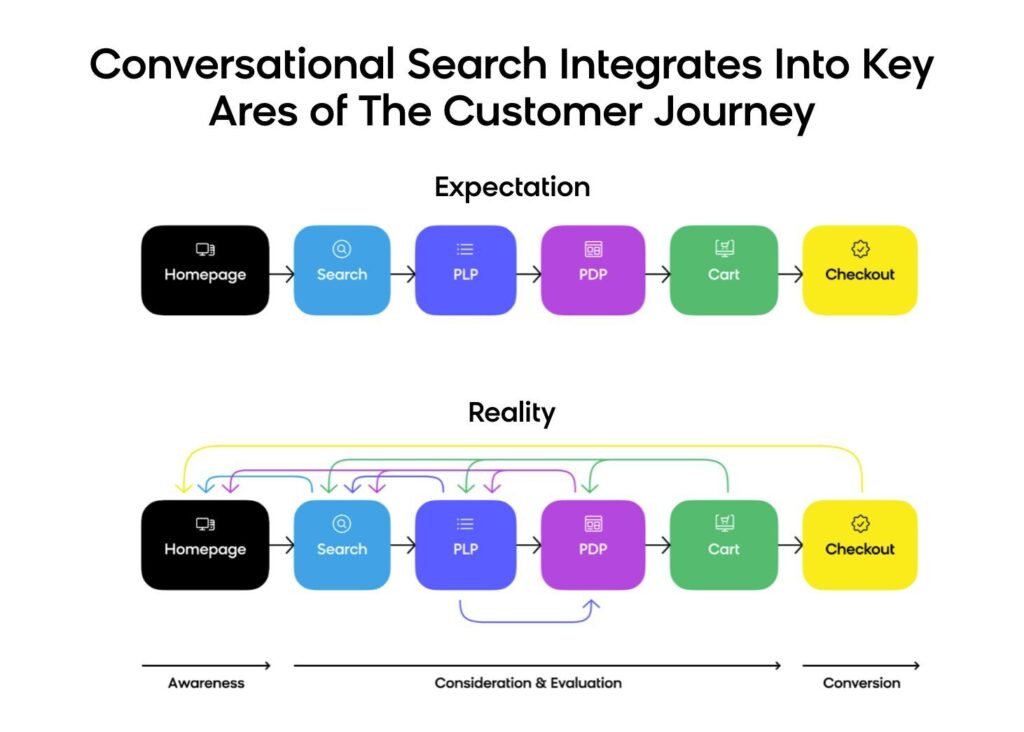When you actually sit down and think about it, isn’t it crazy that the earliest days of trade and commerce date back to the Neolithic period in the year 10,000 BCE? From there, the development of commerce continued in Mesopotamia (3,500 BCE), in Egypt (3,000 BCE), and on the Silk Road (130 BCE), an extensive network of trade routes that connected the East and West.
And even though it’s still difficult to pinpoint the exact time when merchandising began, all of these different iterations of commerce played a significant role in shaping its global history, fostering its economic development, and promoting its cross-cultural interaction and understanding.
Today, ecommerce merchandising is undergoing its own transformation — one driven by artificial intelligence (AI). We’re entering a new era where AI tools are actively shaping merchandising strategy and customer expectations. Through autonomous systems that learn and adapt in real time, merchandising is anticipating shoppers’ needs by continuously improving without the constant need for manual input.
Like its historical predecessors, this new and sophisticated process blends science and art, combining creative elements with data-driven decision making to create relevant, personalized shopping experiences at scale. All in all, AI is adding a new layer of intelligence that turns static product grids into dynamic, self-optimizing discovery engines.
Before we get into what to look for in a future-looking ecommerce merchandising tool, let’s explore the topic of ecommerce merchandising, its similarities and differences from traditional merchandising, and the hottest trends surrounding it today.
Key Takeaways
- Like the historical evolution of commerce, today’s merchandising is being reshaped by technologies like generative AI. The technology helps brands personalize experiences at scale and respond to shopper (and browser) behavior in real time.
- Today’s merchandisers juggle multiple roles, such as content creation, personalization, and A/B testing, while managing vast product catalogs and multilingual sites. Without the right tools, it’s difficult to scale efforts or drive consistent, measurable impact.
- Top-performing merchandising platforms offer built-in intelligence, live audience segmentation, diagnostics, conversational search, and contextual recommendations. These features help teams work smarter, reduce friction for shoppers, and increase revenue with less manual effort.
What Is Ecommerce Merchandising and Why Does It Matter?
At its core, ecommerce merchandising is about how your brand strategically displays and promotes products on your ecommerce site to boost revenue, foster customer satisfaction, and bridge the gap between offline and online shopping. Think of it in its simplest form: display layout, product curation and categorization, and promotional activities that create compelling user journeys for your online shoppers.
As the digital landscape continues to evolve with AI, so must your ecommerce merchandising strategy. With the rise of autonomous discovery and conversational shopping, online retailers can now improve brand perception and gain a competitive advantage in the increasingly crowded commerce space.
How Is Digital Merchandising Different From Traditional Merchandising?
Even though digital merchandising and traditional merchandising both aim to present and promote products in an appealing manner to drive sales, they differ in several key ways:
- Platform – Digital merchandising takes place on digital platforms, like websites and mobile apps, while traditional merchandising occurs in brick-and-mortar stores
- Customer interaction – Though conversational commerce is shaking up dynamics, customer interactions are virtual in ecommerce, with no face-to-face communication or physical touchpoints. Traditional merchandising relies on in-person interactions where customers can physically examine products before purchasing them.
- Product presentation – Digital merchandising utilizes high-quality images, videos, and detailed descriptions to showcase products, whereas traditional practices rely on what’s called visual merchandising (e.g., physical displays, product positioning, and/or store layout)
- Global reach – Ecommerce sites cater to a global audience, allowing businesses to expand their customer base without geographical limitations. Traditional merchandising is restricted to the local area of the physical store.
- Operating hours – Ecommerce stores operate 24/7, providing customers with constant access to products and services, while brick-and-mortar stores have fixed operating hours that limit the times and days customers can shop
Despite these differences, both approaches share a common goal of displaying products appealingly to encourage purchases — and even increase purchase size — for expedited business growth.
What Are the Most Popular AI Merchandising Trends?
Now that you’re aware of the similarities and differences between traditional merchandising and digital merchandising, here’s a look at the most popular AI merchandising trends happening in the market. Among them are dynamic categories, proactive merchandising recommendations, and adaptive shopper experiences — all of which contribute to more engaging, intuitive, and successful ecommerce merchandising practices.
Dynamic Categories and Maintenance
If you’re on the forefront of what’s happening in the merchandising space, you’ve most likely noticed the release of more AI-forward features like dynamic categories. At its core, dynamic categories analyze product attributes and customer behavior in real time and automatically generate campaign-specific categories, such as “Valentine’s Day gifts,” which helps merchandisers adapt to the faster cycle of trends we experience in the news, social media, and more.
GenAI can also monitor inventory changes and update categories as products are added and removed. With real-time maintenance, merchandisers can avoid the usual toil of manual updates and minimize the risk of outdated or irrelevant categories. Overall, this trend towards automation in merchandising improves the shopper experience by presenting customers with timely and pertinent product selections.
Proactive Merchandising Recommendations
GenAI continues to exceed our expectations as it develops, and now it’s advanced enough to empower merchandisers with predictive insight. Instead of relying on static dashboards or gut instinct, GenAI actively analyzes product performance, customer behavior, and market patterns to suggest high-impact actions. Whether it’s identifying underperforming categories, spotting missing sales opportunities, or recommending changes to product order grouping, these insights are delivered for merchandisers to quickly go from insight to execution.
By turning diagnostics into action plans, GenAI helps merchandisers stay ahead of trends using continuous optimizination. Merchandising teams no longer have to piece together takeaways from multiple dashboards or wait for data analysts to interpret the data. With tailored playbooks and recommendations generated in real time, merchandisers can respond to exactly what’s happening in the moment, giving them the space to be less reactive and more proactive with a strategy that drives measurable results.
Adaptive Shopper Experiences
Product discovery has never been a one-size-fits-all experience. One of the benefits of GenAI in your ecommerce tech stack is its ability to create guided discovery journeys that advance as the shopper browses, searches, and even hesitates. These dynamic systems adapt in real time to shopper inputs — surfacing the right products, adjusting to how the results are framed, and helping customers move from the intent to decision stage with less friction.
Responding to inferred intent, GenAI helps merchandisers create more relevant paths to purchase without relying solely on manual intervention. Adjust product order, highlight alternatives, or anticipate the need for a conversational prompt: Use any one of these adaptive moments to boost engagement, reduce abandonment, or drive higher conversions.
The Most Common Roadblocks for Ecommerce Merchandisers
Ecommerce merchandisers face numerous challenges in today’s competitive marketplace. Among the most common roadblocks are juggling multiple job roles and responsibilities, managing an ever-growing number of products and categories, and building more websites in various languages to cater to diverse, global audiences.
Juggling Multiple Job Roles and Responsibilities
Being a merchandiser has always been about balance — balancing artistry with science, balancing industry know-how with customer behavior, and more frequently, balancing the roles they have to play with daily workflows. So, it isn’t uncommon to see merchandisers performing the following roles:
- Content Creator – Ecommerce merchandisers are responsible for creating engaging landing page content for product launches and promotional events, showcasing products or services through visual and textual elements on their online stores
- Site Experience Designer – Going hand-in-hand with content creation, ecommerce merchandisers often focus on optimizing the website’s layout, navigation, and overall user experience to reduce friction, improve conversion rates, and boost revenue
- Personalization Expert – They also must analyze customer data to tailor the shopping experience for each individual, keep track of patterns should those behaviors change, and continually re-optimize the experience
- A/B Test Specialist – Last but not least, ecommerce merchandisers must implement and analyze various tests to determine the most effective strategies for driving sales and repeat purchases in the ecommerce store
This balancing act for ecommerce merchandisers has made their jobs more challenging. With this workload, they can only make an average of 9-13 significant, positive ROI decisions in a given month, which will lead to stagnation for any online business.
Handling an Increasing Number of Products and Categories
Every commerce business wants to drive growth, but you can’t grow your business without expanding your product or service offerings. However, scaling can become a double-edged sword for merchandisers who have to manage the expanding number of products and categories. During these periods, merchandisers must continually optimize site structure, product categorization, and search functionality.
As your product catalog expands, it becomes increasingly more work to maintain accurate and up-to-date information, including product descriptions, images, pricing, and inventory levels. This leads to inconsistencies and errors that may negatively impact the customer experience, resulting in missed sales opportunities and a possibly tarnished brand reputation.
Building and Managing More Sites in More Languages
When it comes to managing websites in multiple geographies and languages, this requires close collaboration with translators or localization teams, as well as a deep understanding of the cultural nuances and preferences of the target audience — that’s a lot of work!
It’s also important to stay informed of local market trends, regulations, and currency fluctuations when managing multilingual sites and coordinating promotions. But you shouldn’t hesitate to adapt your strategies to suit each region’s unique demands. Failing to deliver culturally relevant and linguistically accurate content and product offerings can lead to miscommunication, diminished customer trust, and lost sales opportunities.

5 Software Must-Haves for a Successful Online Merchandising Strategy
To ensure your online store stands out from the competition and hits all of your important metrics, you need to leverage the right digital merchandising tool. Here are five software must-haves to keep in mind for ecommerce merchandising success.
Flexible Product Grid Control With Built-In Intelligence
Modern merchandising tools must give teams the flexibility to manage product grids without relying on engineering support. Features like boost, bury, lock, and block should be standard, but leading platforms will support contextual merchandising that allows product grids to adapt based on factors like campaign goals, audience segments, seasonality, or shopping behavior.
What sets these tools apart is their ability to combine merchandiser control with real-time performance feedback. Merchandisers should be able to preview changes, measure impact on key metrics, and make adjustments quickly, without starting from scratch. This level of flexibility empowers teams to keep merchandising aligned with business strategy and customer sentiment.
Audience Segmentation Capabilities
Understanding your target audience is key to delivering personalized experiences that resonate and keep them coming back for more. But while audience segments will always be essential to merchandising, they shouldn’t be static, eitehr. When you’re evaluating different software solutions, you’ll want to find one that leverages real-time behavioral data, enabling your merchandising team to group customers based on their purchase history, product preferences, and demographics.
Automated segmentation helps eliminate the manual work of building and maintaining segments that might become stale over time. By using live signals, like page views, on-site searches, and cart activity, advanced platforms can dynamically assing shoppers to relevant segments that reflect their current intent. Some solutions go even further by layering in AI to enrich and evolve those segments automatically, paving the way for online shopping experiences to stay targeted, scalable, and responsive to every unique customer journey.
Ranking Diagnostics Tool
No merchandiser is all-knowing. Even in the era of automation, understanding why products rank the way they do is essential. A ranking diagnostics tool offers that visibility and analyzes factors, like click-through rates, bounce rates, and search behavior. It reveals the drivers behind each result set and product grid, whether a product is ranking too low, not surfacing at all, or showing up in an unexpected place.
For instance, the insights gathered from a ranking diagnostics tool can identify if a synonym should be eliminated, if there’s an error in a specific product attribute within the feed, or if certain products need to be promoted or demoted. With this information, merchandisers can decide whether to enact (or override) AI-based recommendations for better results, depending on the inner workings of the company and their goals.
Conversational Search
Traditional “smart search” might include autocomplete, autocorrect, and synonym matching, but with GenAI, we’re moving away from this search infrastructure at a rapid pace. Conversational search represents a more human approach to search that allows shoppers to search the way they naturally speak. You can search for phrases like “a cozy sweater for fall” or “a gift for my sister who loves skincare,” and conversational search understands intent — not just search terms — to deliver results that feel more human.
Conversational search gives merchandisers a direct line to shoppers without forcing them to wrestle with filters or guess the right keywords. With a conversational shopping agent embedded throughout the journey, from the search bar to the product pages, customers get real-time guidance that mimics the expertise of your best in-store associate. The tool helps them navigate non-linear paths to purchase, removes uncertainty, and turns hesitation into action. As a result, you can remove dead ends, simplify tough decisions, and drive stronger outcomes for your business.
Contextual Recommendations
Recommendation widgets have long been a staple of ecommerce, but their effectiveness depends on more than just matching preferences. The best merchandising solutions now deliver contextual recommendations, which are shaped based on a shopper’s behavior, journey stage, and product signals. Your team can set up AI to suggest complementary products on a PLP or surface alternative brands in moments of hesitation, moving a customer forward in their purchase decision.
In reducing decision fatigue, your brand can increase average order value (AOV) by guiding customers to the products or services that they’re most likely to act on. When recommendations are placed with purpose,they become a measurable contributor to revenue, helping to reduce drop-off and pushing more shoppers across the finish line.
Let Bloomreach Show You How Ecommerce Merchandising Is Done
If merchandising is an ancient craft, then ecommerce merchandising is a modern art. But your merchandisers can’t do it alone and be impactful enough to scale your company. Success in today’s digital marketplace demands a collaborative approach that combines the skills of your merchandising team with advanced AI technologies like Bloomreach.
In harnessing the power of innovative tools, you can create an online shopping experience that captivates customers and sets your brand apart from the competition. All you need to do is balance the time-tested principles of merchandising’s past with the groundbreaking technological possibilities of the present and future.
Want to learn more about creating an effective ecommerce merchandising strategy? Try our search impact validation and experience firsthand how your customer data plugs into Bloomreach.




















